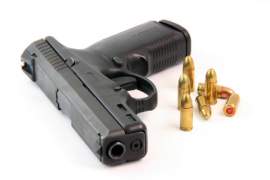
Gun Manufacturing Explained

Gun manufacturing in the United States is an enormous, often times ignored industry. Small arms manufacturing in the United States accounts for 177 companies totaling 9,978 employees. Because of the lenient gun laws in America these companies are very profitable and demand is constant-companies have a combined annual revenue of 3.5 billion dollars.
The industry is highly concentrated and most demand is driven by hunters, gun enthusiasts, and law enforcement agencies. The industry is also not common, it is highly labor-intensive (average annual revenue per worker is $200,000) and advertising is regulated by law.
The manufacturing industry for guns has two unique characteristics-it is highly concentrated and demand rarely fluctuates. Although nearly 200 gun manufacturers exist, the majority of firearms are produced by 5 large companies. Gun statistics in regards to manufacturing reveal that the industry is an oligopoly in nature. 55% of the pistols market and 72% of the rifle market are controlled by the 5 largest producers, while 86% of the shotgun market is controlled by Mossberg, H&R, and Remington.
The gun industry produces more than 3 million guns per year: 40% are pistols and revolvers, 35% are rifles, and 25% are shotguns or all other firearms. With loose gun laws in America it is interesting to note that the majority of firearms produced are handguns. Gun control advocates will point to these gun statistics as a catalyst for America's high violent crime rates. 60,000 machine guns are produced annually as well, but these firearms are mostly distributed for government and military use.
Like many markets, the gun industry has leading producers for their various segments. Sturm, Ruger is the only truly diversified company within the market-they produce all 4 categories of firearms. Remington specializes in rifles and shotguns; Smith & Wesson is the leader in producing handguns and pistols. As stated earlier demand rarely fluctuates based on hunting, self-protection, and law enforcement needs, however, the market is sensitive to changes in government policy and legislation.
Gun statistics in terms of manufacturing reveal a small percentage increase every decade up until the 1980's. Shortly after 1981, manufacturing numbers dramatically decreased. Strict gun laws were the factor for this overall dip of 30% in the market. Gun statistics reveal that the decline in the market was most effected by the lack of handgun production.
From 1980-2000 handgun production fell by over 1 million guns annually. Manufacturers produced 1.3 million a year as oppose to their accustomed amount of 2.3-2.5 million. More stringent gun laws are the main factor for this decrease. Major American city's such as New York, Washington, and Chicago placed a ban on handguns and numerous state governments imposed restrictions in regards to purchasing, owning, and carrying such weapons.
The more rigid gun laws in America were aimed directly at handguns, with intentions to lower violent crime in the states. The adoption of scrupulous gun laws seemingly had no effect on the shotgun or rifle market- shotguns dipped only slightly, from 1.3 million to 1.1 million while rifles shrank from 1.9 million to 1.6 million.
Gun statistics for the manufacturing and production of firearms reveal that the gun market is unique in structure and fundamentals. Unlike most industries, the gun market is not susceptible to recessions or changes in technology, but solely, to government intervention and the adoption of more stringent gun laws.
NEXT: What You Need to Know About Large Volume Gun Sales




















